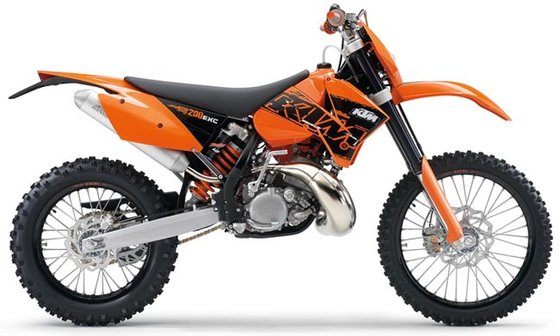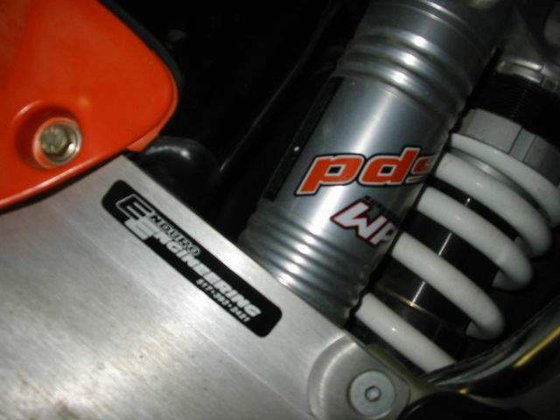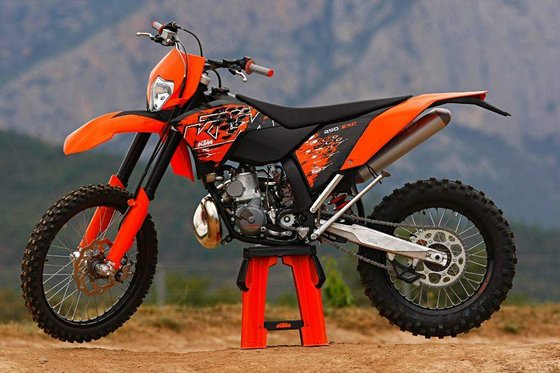KTM 250 EXC (2004–2007): A Legacy of Lightweight Aggression

When the KTM 250 EXC burst onto the enduro scene in the mid-2000s, it didn’t just arrive—it announced itself with a scream of two-stroke bravado. Designed for riders who crave a visceral connection to the trail, this Austrian machine became a benchmark for hardcore off-road performance. Between 2004 and 2007, the 250 EXC solidified its reputation as a lightweight, high-revving weapon that rewards skill and punishes complacency. Let’s dissect why this generation remains a cult favorite among enduro enthusiasts.
Engine Performance: The Heart of a Rebel
At the core of the KTM 250 EXC lies its 249cc liquid-cooled two-stroke engine—a masterpiece of simplicity and raw power. With a bore and stroke of 66.4mm x 72mm, this single-cylinder beast delivers a compression ratio of 11.0:1, fed by a Keihin PWK 36 S AG carburetor. The result? A powerband that’s as explosive as it is addictive.
The Two-Stroke Thrill
Crack the throttle, and the 250 EXC transforms into a kinetic riot. Low-end torque pulls you out of corners with authority, but it’s the mid-to-top-range hit that defines this bike. Once the power valve opens (adjustable via color-coded springs on later models), the engine howls to life, launching the bike forward with a ferocity that four-strokes struggle to match. Riders accustomed to modern thumpers will need to recalibrate their reflexes—there’s no engine braking here, just unadulterated acceleration.
The 5-speed gearbox is a study in precision. Shifts are crisp, and the ratios are perfectly spaced for technical trails. First gear crawls through rock gardens, while fifth lets you stretch its legs on fire roads. But let’s be clear: This isn’t a road bike. At 90 km/h (56 mph), vibrations creep in, reminding you that asphalt is merely a means to reach dirt.
Handling and Suspension: Dance Partner or Drill Sergeant?

Chassis Dynamics
KTM’s chromium molybdenum frame strikes a delicate balance between rigidity and flex. At 1,481 mm (58.3 inches) of wheelbase and a 26.5° rake angle, the 250 EXC feels telepathic in tight singletrack. Flicking between trees becomes second nature, thanks to a dry weight of just 102.6 kg (226 lbs). But this agility comes at a cost: At high speeds, the front end can feel nervous over rutted terrain. Installing a steering damper (a popular aftermarket upgrade) tames the twitchiness without dulling responsiveness.
WP Suspension: Precision Over Plush
The 48mm WP USD forks and WP PDS rear shock are set up for aggression. With 300 mm (11.8 inches) of front travel and 335 mm (13.2 inches) out back, the suspension eats up roots and rocks—provided you’re standing on the pegs. Sit down, and the firm damping reminds you this is a race-bred machine. Lighter riders might soften the compression settings, but the stock setup shines when pushing hard through choppy terrain.
Ergonomics and Comfort: Built for Battle, Not for Lounging

At 925 mm (36.4 inches), the seat height caters to long-legged riders—a necessity for ground clearance of 385 mm (15.2 inches). The narrow profile lets you grip the bike with your knees, but the seat itself is about as forgiving as a park bench. After two hours in the saddle, you’ll understand why aftermarket seat pads are a popular upgrade.
Standing up, the ergonomics shine. Renthal’s tapered handlebars and aggressive peg placement create a natural attack position. The hydraulic Magura clutch (light as a feather) and Brembo brakes (with a biting 260mm front rotor) complete the premium touchpoints. Just don’t expect frills like handguards—this is a purist’s machine.
Competition: How Does the 250 EXC Stack Up?

Yamaha WR250F
Yamaha’s four-stroke WR250F appeals to riders who prefer tractable power and engine braking. It’s smoother and more forgiving, but at 113 kg (249 lbs), it can’t match the KTM’s flickable demeanor. Maintenance is also costlier—valve adjustments vs. the EXC’s simple top-end rebuilds.
Honda CRF250X
Honda’s CRF250X counters with legendary reliability and electric start. Its power delivery is linear, making it friendlier to novices. Yet in technical climbs, the KTM’s explosive torque and 12 kg (26 lbs) weight advantage let it claw ahead.
Husqvarna WR250
Husky’s two-stroke WR250 is the EXC’s closest rival. Both share similar powerbands, but the Husqvarna’s linkage rear suspension offers plusher damping. However, KTM’s aftermarket support (think MOTOPARTS.store for sprockets, chains, and performance kits) gives it the edge for customization.
Maintenance: Keeping the Beast Alive

Critical Service Points
- Premix Fuel: Run a 60:1 ratio with high-quality synthetic oil.
- Air Filter: Clean every 10–15 hours—critical for carbureted engines.
- Spark Plugs: NGK BR8ECM (gap 0.6 mm) ensures crisp ignition.
- Chain & Sprockets: The 5/8 x 1/4" X-ring chain lasts longer with regular lubrication. Swap worn sprockets (14/50 teeth) to maintain acceleration.
- Suspension: Rebuild WP forks annually with SAE 5W oil.
Pro Tips
- Cooling System: Use ethylene glycol coolant and check for leaks—the radiators are vulnerable in crashes.
- Brakes: DOT 4 fluid resists boiling during descents.
- Tires: 1.0 bar (14.5 psi) front / 1.0 bar rear for soft terrain; 1.5 bar (21.7 psi) front / 2.0 bar (29 psi) rear on hardpack.
Conclusion: The Last of the Wild Ones
The 2004–2007 KTM 250 EXC isn’t just a motorcycle—it’s a rebellion against sanitized riding experiences. Its two-stroke engine demands respect, its suspension rewards aggression, and its lightweight chassis forgives mistakes. While modern four-strokes dominate showrooms, this generation remains a testament to an era when riding required skill, nerve, and a love for the smell of premix.
For owners, MOTOPARTS.store stands ready to keep your EXC sharp—whether you’re upgrading the carburetor jetting or fitting a softer seat for those marathon trail days. Because legends deserve to stay on the trail, not in the garage.
Specifications sheet
| Engine | |
|---|---|
| Stroke: | Two-stroke |
| Max power: | 37 kW | 50.0 hp |
| Max torque: | 42 Nm |
| Fuel system: | Keihin PWK 36 S AG Carburettor |
| Max power @: | 8500 rpm |
| Displacement: | 249 ccm |
| Bore x stroke: | 66.4 x 72.0 mm (2.6 x 2.8 in) |
| Configuration: | Single |
| Cooling system: | Liquid |
| Compression ratio: | 11.0:1 |
| Lubrication system: | Mixture oil lubrication 1:60 |
| Number of cylinders: | 1 |
| Dimensions | |
|---|---|
| Wheelbase: | 1481 mm (58.3 in) |
| Dry weight: | 103 |
| Seat height: | 925 mm (36.4 in) |
| Ground clearance: | 385 mm (15.2 in) |
| Fuel tank capacity: | 9.5 L (2.5 US gal) |
| Drivetrain | |
|---|---|
| Chain type: | 5/8 X 1/4" X-RING |
| Final drive: | chain |
| Transmission: | 5-speed, hydraulic wet clutch |
| Rear sprocket: | 50 |
| Front sprocket: | 14 |
| Maintenance | |
|---|---|
| Rear tire: | 140/80-18 |
| Engine oil: | 15W50 |
| Front tire: | 90/90-21 |
| Brake fluid: | DOT 4 |
| Gearbox oil: | SAE 30 |
| Spark plugs: | NGK DCPR8E or NGK DCPR8EIX |
| Spark plug gap: | 0.6 |
| Coolant capacity: | 1.3 |
| Forks oil capacity: | 1.5 |
| Engine oil capacity: | 1.25 |
| Gearbox oil capacity: | 0.8 |
| Engine oil change interval: | Every 30 hours or 500 km |
| Recommended tire pressure (rear): | 2.0 bar (29 psi) |
| Recommended tire pressure (front): | 1.5 bar (22 psi) |
| Additional Notes | |
|---|---|
| Starter: | Kick |
| Exhaust system: | Aluminum expansion chamber |
| Frame material: | 25CrMo4 steel |
| Fuel mixture ratio: | 1:60 (pre-mix) |
| Chassis and Suspension | |
|---|---|
| Frame: | Chromium molybdenum double cradle |
| Trail: | 112 mm (4.4 in) |
| Rear brakes: | Single 220 mm disc, 1-piston caliper |
| Front brakes: | Single 260 mm disc, 2-piston caliper |
| Rear suspension: | WP PDS monoshock |
| Front suspension: | WP USD 48 mm inverted fork |
| Rake (fork angle): | 26.5° |
| Rear wheel travel: | 335 mm (13.2 in) |
| Front wheel travel: | 300 mm (11.8 in) |



















